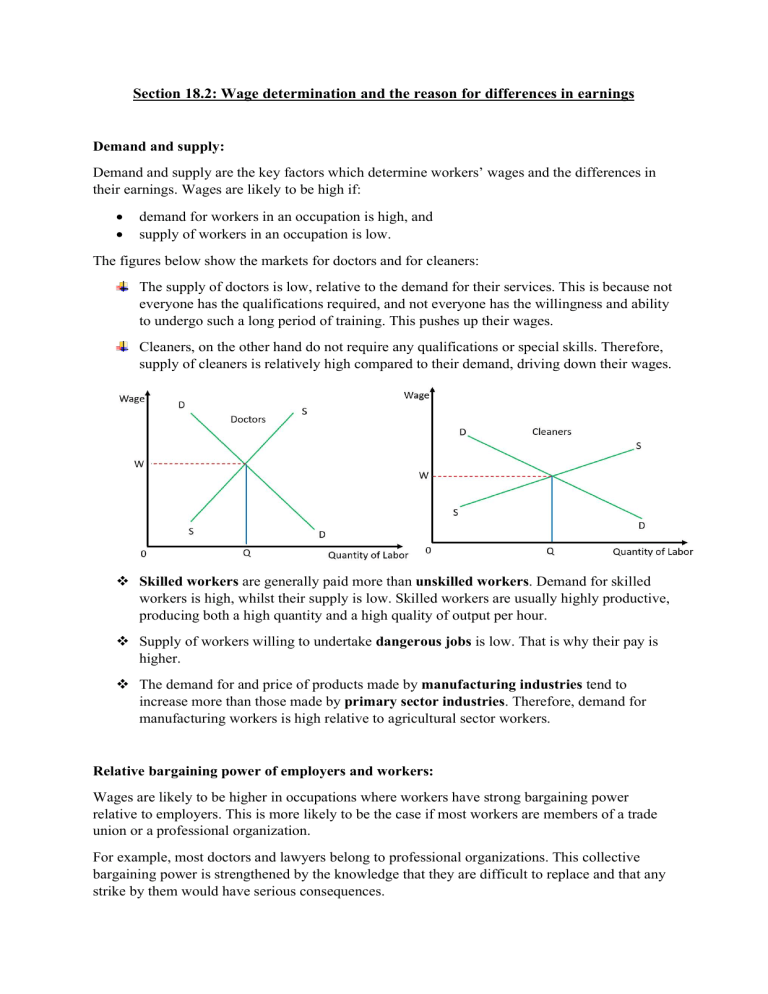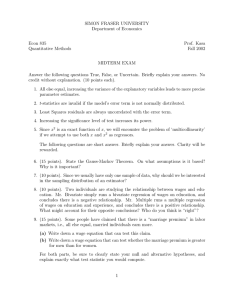
Section 18.2: Wage determination and the reason for differences in earnings Demand and supply: Demand and supply are the key factors which determine workers’ wages and the differences in their earnings. Wages are likely to be high if: demand for workers in an occupation is high, and supply of workers in an occupation is low. The figures below show the markets for doctors and for cleaners: The supply of doctors is low, relative to the demand for their services. This is because not everyone has the qualifications required, and not everyone has the willingness and ability to undergo such a long period of training. This pushes up their wages. Cleaners, on the other hand do not require any qualifications or special skills. Therefore, supply of cleaners is relatively high compared to their demand, driving down their wages. Skilled workers are generally paid more than unskilled workers. Demand for skilled workers is high, whilst their supply is low. Skilled workers are usually highly productive, producing both a high quantity and a high quality of output per hour. Supply of workers willing to undertake dangerous jobs is low. That is why their pay is higher. The demand for and price of products made by manufacturing industries tend to increase more than those made by primary sector industries. Therefore, demand for manufacturing workers is high relative to agricultural sector workers. Relative bargaining power of employers and workers: Wages are likely to be higher in occupations where workers have strong bargaining power relative to employers. This is more likely to be the case if most workers are members of a trade union or a professional organization. For example, most doctors and lawyers belong to professional organizations. This collective bargaining power is strengthened by the knowledge that they are difficult to replace and that any strike by them would have serious consequences. On the other hand, cleaners do usually not belong to a workers organisation and can easily be replaced further reducing their bargaining strength. Public sector workers are more likely to belong to a trade union or a professional organisation than their counterparts in the private sector. Public sector workers also tend to be affected more by government labour market policies. Government policies: Government policies affect wages in a variety of ways. A government clearly influences wages of workers in the public sector, but its policies also influence the wages of workers in the private sector. Specific government policies may have an impact on particular occupations: e.g. If the government legislates that drivers need to take a driving test every 10 years, demand for driving instructors will rise, pushing up their wages. Government labor market policies directly affect wages. One of the best-known policies is the national minimum wage (NMW) – a minimum rate of wage for an hour’s work, fixed by the government for the whole economy. The main aim of the minimum wage policy is to raise the pay of low-paid workers and reduce poverty. To have any impact on wages, however, a minimum wage has to be set above the market equilibrium wage. This has caused some economists and politicians to argue that it may cause unemployment. (Illustrated below). Other economists argue that a NMW can raise both the wage rate and employment. They think that this is for two reasons: A higher wage to workers will raise their motivation and therefore their productivity. Higher wages will increase spending, resulting in higher demand for products, which will in turn increase demand for labour (to supply more products). The figure below illustrates that if demand for labour does increase, the equilibrium wage rate may be equal to NMW: Public Opinion: Public opinion tends to consider that jobs which involve long periods of study and training should be highly rewarded even though there are variations in different countries. Public opinion can influence wage rates in a number of ways. One is through the wage rate claims made by the workers. For example, if the police get a pay rise, firefighters are likely to seek an equivalent pay rise. Also, in some cases, public opinion can put pressure on the government to raise wages of, for example, nurses. A government seeking to gain or maintain popular support, may feel compelled to raise nurses’ pay. Discrimination: Discrimination occurs when a group of workers is treated unfavourably in terms of employment, the wage rate, the training received and/or promotional opportunities. The lower demand will result in lower pay, as shown in the figure below. Governments are increasingly taking actions against discrimination, making it illegal. A point to note is the gender pay gap – all around the world, women are still (on average) paid less than men. Excluding working hours, there are a number of reasons for this: women tend to be less qualified than men – but this is changing in a number of countries women tend to be heavily concentrated in low-paid occupations women are less likely to belong to trade unions and professional organisations women are still discriminated against


